Let’s Take a Trip to an American Village
July 12, 2009
We continue our tour of villages with a visit to an American village.
March 3, 2009: Let’s Visit Some More Villages
February 15, 2009: Let’s Take a Trip to the French Village
February 1, 2009: Let’s Take a Trip to the English Village
This is, actually, the village I live in: New Berlin, NY 13411. Population about 1000. It is in one of deepest economic backwaters of upstate New York. Not much has been built here since 1915 — so it has been left in something close to its original 19th century state, or at least has not been overrun with 20th century suburban crap. It was, as we will see, a rather prosperous spot in the late 19th century, with five hotels! The main industry was agricultural, primarily eggs and cheese to be shipped to New York City. There is a factory that, during World War II, was the largest powdered egg factory in the world. Borden’s Condensed Milk also had a large factory, and there was a textile mill.
The town was formed from Norwich in 1807, so the layout represents early 19th century thinking. This was about 120 years before the automobile. However, as we will see, the American village does not look like the English, French, German or Italian village, let alone the Chinese of Japanese village. Those are all clearly urban places, while the American village … looks just the same as the idealized American suburb. Let’s take a trip along Main Street, from the south end of town to the main intersection. (There is only one stoplight in town.) This is about a quarter mile.

Here’s South Main Street. Your basic two-laner with room to park at the curb on both sides.

We’re walking along the sidewalk. But, there is not just a sidewalk, but also a strip of greenery on both sides of the sidewalk. So, the actual width of the “sidewalk” is quite wide. I would say there’s about fifteen feet here. Plus fifteen feet on the other side of the street. Plus two lanes of traffic, plus room for parking at the curb. So, this is plainly NOT a Really Narrow Street, or even a Narrow Street. It is pretty darn wide. There is probably at least 100 feet from building to building. While there should be a few larger streets for transportation, we will see that there aren’t really any streets in this town that are any narrower than this. Why were they so big? This was laid out around 1800. It wasn’t for cars. And, the European precedent is clearly for narrower, urban streets. I’ve heard that streets were made wide enough that you could make a U-turn with a horse-drawn wagon. So, right from the start, we have a somewhat irrational focus on transportation, which, as we will see, is a theme throughout even though this is 120 years before cars.
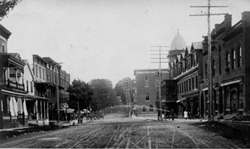
This is a vintage photo of Main Street from a little north of the intersection, looking south. Look at the distance between the buildings. Isn’t that a little excessive? There’s enough room for about six to eight parallel lanes of wagon traffic — although the wagon traffic that actually exists in this picture is One Wagon. Admittedly, this is Main Street, but there aren’t any smaller streets in this town. Note the difference between Main Street and this street in a French village:

We see that the street in the American village is not just “a little wider,” it is about ten times wider. However, the size of humans hasn’t increased. There are consequences when you make your city ten times bigger but the size of humans remains the same. Also, note that Main Street is dirt in the above photo. Normally, in the European model, a street in the center of town would be paved with stones. Like the paving stones on this French street. But, when you make the street ten times wider, that becomes a mammoth job.
Let’s keep walking along Main Street:

After a few steps we come to a house. This is a rather nice house for the village, although it is suffering from deferred maintenance. I’d guess it was built around 1840. We see that people weren’t poor in those days. This is a serious house. It looks to be about 4000 square feet, and the construction quality is better than anything built today, including stuff in the $1m+ range. You might laugh, but what is YOUR house going to look like in 169 years?
So, along from our somewhat irrational focus on Really Wide Streets and transportation, we also have Really Huge Houses. It is not just Really Huge. Wealthy people have always had big residences. A floor-through penthouse on the 60th floor in Manhattan can also be 4000 sf. Some of those old brownstones are seriously huge as well. And, in those days, there were seven family members and two servants living there. However, we see that this is NOT an urban mode of construction. It is not an apartment or townhouse. It is a rural mode. This is not just an “imitation” or “ersatz” farmhouse, it is a farmhouse, totally indistinguishable from the farmhouses dating from the same era, in the surrounding countryside. So, also from an early time, we see in the American village a failure to adopt traditional urban modes of design in urban areas. This is totally different than, for example, the Florentine mode of construction:

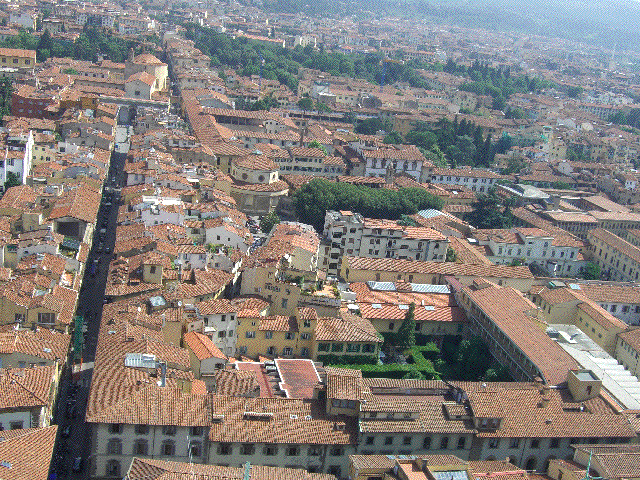
To some degree, this decision is an aesthetic consequence of the original decision, to make the streets Really Wide. Once you start spacing things out, they tend to get even more spaced out.
Not only is this house a freestanding, detached “farmhouse-style” building, it sits on its own micro-farm. Most houses in the village of New Berlin are on lots of 0.25 to 0.5 acres. That, you will recognize, is the same as suburban homes today, and vastly larger than typical urban townhouse lots. Some are larger: my house has a four-acre yard, but is still inside the village, if you can believe that.
What else is on this 0.25 acres? Well, out back behind our enormous 4000sf farmhouse is:

This building. What is it? Obviously it is not a garage, because this predates automobiles by 80 years. We can also see that it is quite enormous, and obviously built with great care and pride — not just a utility building.
It’s a carriage house.
The thing to do in the mid-19th century was to maintain a carriage. This was no joke: you had to have at least one horse and maybe several, which you had to feed all winter. (The small door over the main door leads to the hayloft.) What was the carriage for? I said before that, in the tradtional village, you didn’t need all this stuff, because you could walk around town and lead an urban lifestyle, even if your village was very small and out in the country. How many carriage houses do you see in this French village?

Close to zero. Most people would say: “Well, in the days before cars, if you wanted to get anywhere you needed a carriage. Duh!” Like it was that obvious. Have you ever tried to maintain two horses, and yoke them to a carriage? (I suppose that’s what servants are for.) In a small town, you should be able to walk around the town, and then if you wanted to go to another town, you could take a “bus” (shared carriage). Actually, despite the Really Wide Streets, you can walk around New Berlin. So, a carriage was not at all necessary to get around the town. And, as we will see, there was also a train which connected the villages. The point is, our weird American fascination with personal transportation dates from FAR before the automobile.

This shows the distance between houses. You can see the white house and carriage house on the right. That is a BIG distance between houses. You could fit a couple nice townhouses right in there.

Here are some townhouses from about the same mid-19th century period. This is San Francisco. Townhouses are an example of an urban format, which we clearly do not have in our American village. (These townhouses even have garages.)
I suppose people are starting to whine now: “But …. grass is nice! We need GREEN SPACE.” I’ll talk about “green space” at some future point. My point today is: if you make your roads 10x larger, and your houses on 4x-10x larger plots of land, but people are the same size, there are consequences. For one thing, you have to walk 10x farther to do anything. I imagine that would make you start to fantasize about carriages before too long.
The American village was dysfunctional from the start.
Let’s continue our walk along Main Street.
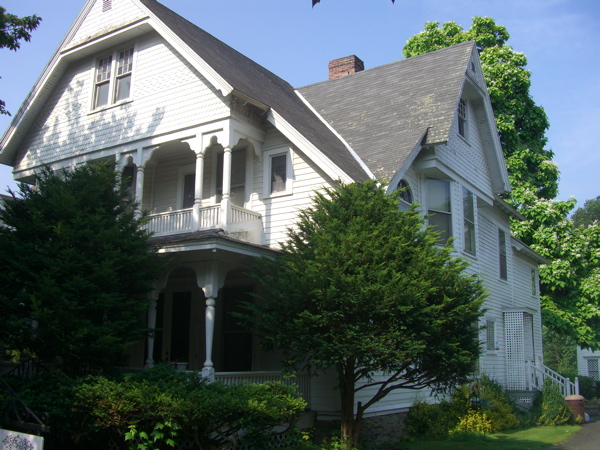

This lovely stone mansion was completed in 1831. It is now a bed and breakfast, and is on the National Register of Historic Places. It is known as the Preferred Manor.

The entrance foyer of the Preferred Manor. There is a spring in the basement!

Preferred Manor living room. This is how these old houses were decorated. Wow!


Preferred Manor bedroom. It is not very expensive to stay there for a night.
As you can see, in terms of aesthetics and quality, we haven’t accomplished much in the last 178 years.

Front of the Preferred Manor.


Nice house. A little old lady lives here.

Same house. It is big! A carriage house in the back, of course.

The other side of the same house. It goes on an on … with multiple chimneys.


Continuing our walk. We’ve gone about 200 yards so far.
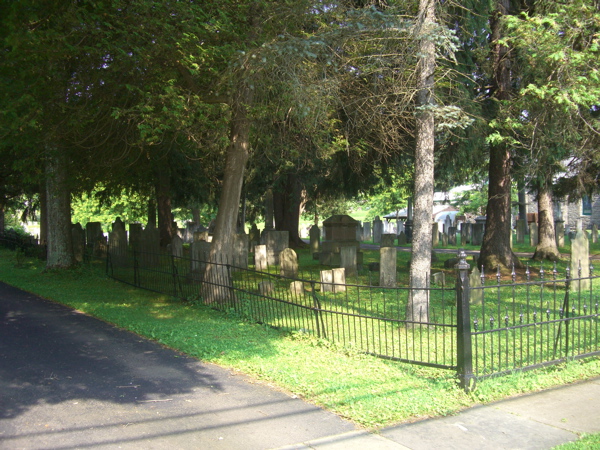


Nice church! It opened in 1808. A real slate roof.


I guess this is the pastor’s house.

A few more steps brings us to …
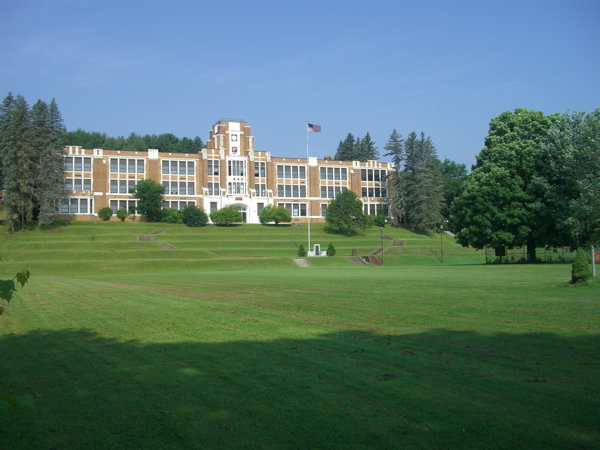
The public school. I think this is the most beautiful public school I’ve ever seen. Unfortunately, due to declining enrollment, it was sold a few years ago, and became a private school.
Many schools from that period are astonishing.

Central High School, Detroit, Michgan. A cathedral of public education!

A brand new high school. In the 1880s, even a glue factory or a meat packing plant wouldn’t be made as ugly as this.
I think that is enough for this week. We’re going to max out the servers as it is. We will continue our tour of an American Village in the future.
I think of this area as the Yankee Heartland, which can be loosely defined as the colonial regions north of Virginia. Most of the Yankee Heartland has disappeared under the strip mall development of the 20th century. You have to go to quiet little backwaters like this to find it in something like its original state.
You can see that our civilization has deteriorated considerably from that time. People in those days did a pretty good job. They made things of lasting beauty. At the same time, the seeds of our suburban self-destruction are clearly evident. So, it doesn’t make too much sense to imitate that period in all ways, because we wouldn’t resolve the inherent problems of that time. I would like to retain the best of that period, but also fix the problems. This sounds difficult, but actually it is quite easy to do. It’s as simple as:
Really Narrow Streets
I said earlier that you needed to concentrate on:
1) Really Narrow Streets
2) Buildings close together (usually multistory)
3) No cars.
In that order. If you mess up the Really Narrow Streets part, the fact that you don’t have cars, or that the buildings are close together won’t solve the problem.

Village in the Alsace region, France.
Other commentary in this series:
March 3, 2009: Let’s Visit Some More Villages
February 15, 2009: Let’s Take a Trip to the French Village
February 1, 2009: Let’s Take a Trip to the English Village
January 25, 2009: How to Buy Gold on the Comex (scroll down)
January 4, 2009: Currency Management for Little Countries (scroll down)
December 28, 2008: Currencies are Causes, not Effects (scroll down)
December 21, 2008: Life Without Cars
August 10, 2008: Visions of Future Cities
July 20, 2008: The Traditional City vs. the “Radiant City”
December 2, 2007: Let’s Take a Trip to Tokyo
October 7, 2007: Let’s Take a Trip to Venice
June 17, 2007: Recipe for Florence
July 9, 2007: No Growth Economics
March 26, 2006: The Eco-Metropolis
* * *
Selling British debt: The GEAB LEAP/E2020 (whatta name) guys have been saying for months that the U.K. will be the first to hit the funding wall, and that it would happen in July. Pretty bold crystal-balling. Well, it’s July and voila: Pimco and Blackrock say “no mas” to gilts!
July 9 (Bloomberg) — The biggest gilt investors say U.K. government securities provide little value even though the Bank of England probably will extend its bond-purchase program.
The U.K.’s growing budget deficit and the central bank’s reluctance to say when and by how much it will expand so-called quantitative easing are keeping Pacific Investment Management Co., which runs the world’s biggest bond fund, and BlackRock Inc. from increasing their holdings of the securities.
Guessing which gilts the central bank is going to buy is like “playing Russian roulette,” said Philip Laing, the Edinburgh-based director of government bonds at Standard Life Investments, which has about 118 billion pounds ($191 billion) under management. “While they’ll probably extend it, we are focused on the end of quantitative easing.”
Investors are losing confidence in Prime Minister Gordon Brown’s economy as the government embarks on the biggest fund- raising effort in Britain’s history. The Treasury plans to sell a record 220 billion pounds of gilts this fiscal year to fund bank rescues and stimulus programs designed to pull the economy out of its deepest slump since World War II.
Yields on 10-year gilts will likely rise to 3.97 percent in June 2010 from 3.61 percent yesterday, according to the median estimate of seven strategists and economists surveyed by Bloomberg. Foreign investors cut their gilt holdings since the start of quantitative easing, selling 10.9 billion pounds of the securities in April, the most since at least 1982, according to central bank data. They sold 960 million pounds in May.
http://www.bloomberg.com/apps/news?pid=20601087&sid=aeM3Y2OtASLQ
Pimco and Blackrock tend to set the trend among fixed-income investors in general. Their track records are good enough that you wouldn’t want to be in the meeting where they ask you: “Why were you buying gilts when Pimco and Blackrock said they were a bad deal?” Certainly, at 3.61% you aren’t getting paid enough to risk that conversation.
* * *
The amazing Kenny G: Would you believe that the best selling instrumental artist of all time is … saxophonist Kenny G? He has been credited by RIAA with over 48 million albums sold in the US alone as of 2003, just a little behind U2 at 50 million. (The Beatles are #1 with 170 million, and Garth Brooks is #2 with 128 million. Madonna did 64 million and Michael Jackson 62 million.) His album Breathless sold 15 million copies, the most of any instrumental album ever.
Well heck, why not.
The RIAA stats on total music sales are pretty interesting:
* * *
Recommended reading: The Unnatural History of the Sea, by Callum Roberts, documents human interaction with the oceans since about 1000 AD. Synopsis: it’s much worse than you think. And, even if you think it’s pretty bad, actually it is much worse than that.
Buy The Unnatural History of the Sea from Amazon.com
I figure that, if you’re going to destroy the oceans, at least you should be aware that you are destroying the oceans. That seems like a minimum obligation.
* * *
David Leonhardt forms “Club Wagner”: This is a club for tax hikers, believe it or not. David is a prominent reporter for the New York Times on an economic beat. By itself this is nothing, but I think this indicates conventional wisdom at this time.
The problem with tax-hiking, as I noted in my book, is that it doesn’t actually work. It doesn’t create more revenue, on either an absolute basis or a % of GDP basis. However, it does lead to economic stagnation and decline, which increases the calls on the government for welfare-type contributions of all sorts, which costs money.
Right now this is just hand-wringing. However, if we get another breakdown in the economy towards the autumn, and budget projections need to be marked down again, then we might get “panic revenue-raising action” in the form of rather significant tax increases in 2010. You know that’s what California would be doing right now, if they didn’t have a political process which allowed Californians to tell them “anything but tax hikes.”

